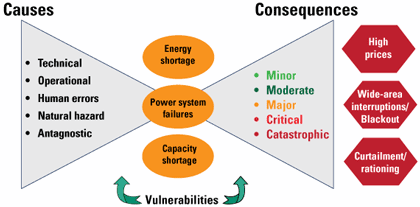
Vulnerability and security in a changing power system
Project description

Objectives
The aim of this project was to build competence and knowledge regarding vulnerabilities related to the changing electric power system, especially due to new requirements and changing operating conditions, and thereby contribute to ensure an appropriate level of security of supply. In particular the project would:
- Establish a scientific basis for monitoring and management of vulnerabilities in a changing power system.
- Provide a methodical framework for analyses of vulnerability and security in the development and operation of the transmission and distribution systems.
The project focused on failures and disturbances in the power grids leading to wide-area interruptions with severe impact on society. The objectives of the project were:
- Establish a framework of definitions, indicators and methods to monitor and classify vulnerabilities in electric power grids.
- Establish methods and operational tools for power system risk and vulnerability analysis.
- Provide new knowledge through 1 - 2 PhD studies within the fields of methods for analysis of extraordinary events and/or risk attitudes and criteria related to wide-area interruptions.
Frontiers of knowledge and technology
The modern society is critically dependent on a secure electricity supply to maintain its functionality. Over the last 10 – 20 years there have been limited investments in new power plants and transmission lines, resulting in a strained power balance and increased utilization of the electric power grids. Climatic and environmental concerns have resulted in new strategies to ensure the security of supply while reducing the CO2-emissions, e.g. the Norwegian climatic agreement, Energi21 and EU202020. The realization of these strategies in terms of integration of large scale renewables and distributed generation, leading to increased power exchange, changing power flows etc., imposes challenges regarding the development and operation of the power system. The current transmission and distribution system is built for the traditional power flow from large sources to demand. It is an ageing infrastructure and the need for reinvestments is expected to increase rapidly the coming years. At the same time the climatic changes may impose increased stress (more wind, icing) on the grids.
Controlling the vulnerabilities in the power grids is essential to handle the security of electricity supply (SoS) in the changing power system. Vulnerability is related to the hazard exposure and may be defined as a characteristic of an element of the critical infrastructure’s design, implementation, or operation that renders it susceptible to destruction or incapacitation by a hazard or threat . Vulnerability management is a relatively new area in the electric power sector according to the literature. There are numerous publications in highly recognized journals such as IEEE Transactions within the field of power system security and reliability, but there are few publications addressing risk and vulnerability analysis of power systems in a broader sense.
It is of great importance to study if and how the vulnerabilities evolve and if the probability of wide-area interruptions is increasing, due to ageing, increased stress etc. The best available database for documenting this on an aggregate (national) level is presumably the failure and interruption statistics. However, these data only contain information about the current components and those that have failed. Reduced investments, less maintenance, work force reductions (40 – 50 % in Norway), and other aspects may have long-term consequences which are of vital importance to know more about. There are few, if any, indicators and data on an aggregate level to monitor and describe the vulnerabilities in quantitative terms, and to identify e.g. underlying mechanisms impacting the technical condition of the network.
Wide-area interruptions have a severe impact on critical societal functions and need to be addressed from a societal security point of view. In risk and vulnerability analysis of electric power systems a major challenge is to identify chains of events that could lead to wide-area interruptions. It is necessary to have knowledge about the underlying causes, as well as data and models for determination of the probabilities for different initiating events, for the propagation of outages and to determine and evaluate the consequences of these cascading outages. Beyond the traditional and deterministic N-1 criterion, there is no established framework on how to analyse and predict the security of electricity supply and vulnerabilities of electric power grids. A vulnerability analysis of the Nordic power system revealed a lack of knowledge on what is a sufficient or acceptable level of security of electricity supply, and how to analyse extraordinary incidents with low probability and severe impact on society.
This situation calls for increasing the knowledge on monitoring and management of vulnerabilities and a methodical framework for handling vulnerability and security in the development and operation of the transmission and distribution systems. As the vulnerability and resilience of the electric power grids greatly affects societal security, there is also a need for knowledge on different stakeholders’ acceptance criteria concerning wide-area interruptions with major impact on society.